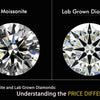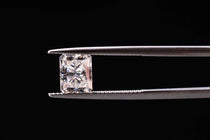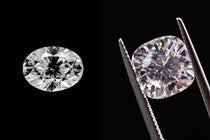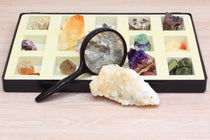Table Of Contents
- What is Moissanite?
- Moissanite vs Diamond: Which is More Beautiful?
- Moissanite and lab created Diamond durability
- Longevity of Moissanite and lab-grown Diamond
- What makes Moissanite different from that of Lab-grown diamonds?
- Comprehensive Comparison guide- Moissanite and lab-grown diamond
- Conclusion
Moissanite and lab-grown diamonds are both gemstones used as substitutes for natural diamonds.
Moissanite is a naturally occurring mineral that was discovered in an Arizona meteorite crater in 1893. It is made of silicon carbide and resembles diamonds in appearance. Moissanite, on the other hand, has a different chemical composition and optical properties than diamonds, giving it a distinct appearance and sparkle.
lab-grown diamonds, on the other hand, are created using advanced technological processes that mimic the conditions in the Earth's mantle where diamonds form. In these processes, small diamond "seeds" are subjected to high pressure and high temperature in a laboratory setting, causing them to grow into larger diamonds. The resulting diamonds have the same physical and chemical properties as natural diamonds, but they are produced in weeks rather than millions of years.
Moissanite and lab-created diamonds are both popular alternatives to natural diamonds because they are less expensive while maintaining a similar appearance and moissanite durability over time. They are frequently used in engagement rings, wedding bands, and other jewelry.
What is Moissanite?
Although moissanite does occur naturally (albeit in very small amounts) in very small crystals, when consumers compare moissanite and diamonds, they are most likely comparing synthetic moissanite. This is a laboratory-created form of crystalline silicon carbide that is widely used as a diamond simulant. Unless you're looking for rare mineral samples, you're likely to come across synthetic moissanite and moissanite rings for sale.
Amazing Radiant Cut Moissanite Engagement Ring, Cathedral Set Moissanite Solitaire Ring
Moissanite vs Diamond: Which is More Beautiful?
The main point of contention in the moissanite vs diamond debate is whether one is more beautiful than the other. Moissanite is unquestionably a convincing diamond substitute.
To know the difference between these two- diamonds and moissanite, jewelry experts generally need a moissanite tester. It is a device that measures electrical conductivity and a loupe for a close visual examination. Customers, on the other hand, may notice subtle differences in their beauty.
Brilliance and Fire
When you look at a diamond, you will notice brilliance (white flashes) as well as fire (colored flashes). Moissanite exhibits both but has more fire than diamond. As a result, moissanite has more colored flashes of light than diamond.
However, this is partly determined by the diamond cut. Older cut styles or modern cuts with specific angles will have more fire than most modern diamonds. This can make distinguishing between the two difficult.
It's difficult to tell the difference between moissanite and diamonds based on brilliance and fire, but it's easier to see at larger sizes. Nonetheless, unless you have prior experience in the jewelry industry, you won't be able to tell the difference based solely on appearance.
Color
Moissanites in the same color range as white diamonds are now widely available. This was not always true. "Classic" moissanite is yellowish or brownish and is frequently compared to diamonds in the J to M range. This collection works best with yellow or rose gold settings and vintage styles.
Moissanite, on the other hand, is available in colors corresponding to the "Near Colorless" G to I range and the "Colorless" D through F range. This provides moissanite buyers with numerous options for replicating their favorite diamond looks and styles.
11.16 CT Marquise Cut Loose Moissanite, Handcrafted Moissanite for Engagement Ring
However, moissanite can change color depending on lighting and may not always appear colorless. Some stones will be more yellow or yellow-green than others. Color-sensitive people may prefer diamond or white sapphire over moissanite.
Clarity
Moissanite does not have the large clarity imperfections that diamonds do because they are grown in laboratories. As a result, moissanite will always be free of visible flaws, whereas diamonds may. For those on a tight budget, finding an eye-clean diamond in the desired size can be difficult. It entails scrutinizing a large number of diamonds. This can take time and may require the assistance of a professional.
Moissanite and lab created Diamond durability
Hardness
With a Mohs hardness rating of 10, diamond is the hardest material. Nothing can scratch another diamond except a diamond. Moissanite is the second-hardest gemstone material, with a hardness of 9.25. It is highly unlikely that your moissanite will scratch unless you store it with diamond jewelry.
Toughness
However, deciding whether moissanite or diamond is a more durable gem material is difficult. People who sell moissanite may claim that it is tougher than diamonds, whereas those who sell diamonds may claim the opposite.
Moissanite lacks a cleavage plane, whereas diamond does. Moissanite benefits from this in terms of moissanite durability over time. This, however, does not help determine how hard a moissanite must be knocked before it breaks.
Longevity of Moissanite and lab-grown Diamond
Moissanite and lab-grown diamonds are both thought to be extremely durable and long-lasting. Moissanite is a naturally occurring mineral, whereas lab-grown diamonds are created using advanced technological processes that mimic the conditions in the Earth's mantle where diamonds form.
Moissanite has a mineral hardness of 9.25 on the Mohs scale, which is second only to diamonds in terms of hardness. This means that moissanite is extremely resistant to scratching and abrasion and is extremely long-lasting. It is also very heat resistant, making it an excellent choice for use in jewelry.
Hidden Halo Engagement Ring, Elongated Cushion Cut Lab Grown Diamond
lab-grown diamonds have the same physical and chemical properties as natural diamonds, as well as the same hardness and moissanite durability. They are grown using advanced technological processes that mimic the conditions in the Earth's mantle where diamonds form. This means that lab-grown diamonds are nearly identical to natural diamonds in terms of hardness and durability.
Moissanite and lab-grown diamonds are both expected to last a long time and to be as beautiful and brilliant as the day they were created or cut. They can last for many years and even generations if properly cared for and maintained.
What makes Moissanite different from Lab-grown diamonds?
Refractive Index:
A gemstone's refractive index describes how much light bends as it passes through it. Moissanite's refractive index is higher than that of lab-grown diamonds, which contributes to its intense fire and sparkle.
Moissanite will bend light more than lab-grown diamonds, resulting in a more gleaming appearance.
Dispersion:
The separation of white light into its spectral colors is referred to as dispersion.
Moissanite has a higher dispersion than lab-created diamond durability, which means it can separate white light into its spectral colors more effectively. In moissanite, this can result in a rainbow-like effect known as "fire."
Ethical Concerns:
Lab-grown diamonds and moissanite are both created in a laboratory and do not require mining or extraction, which can have negative environmental consequences. This means they have a lower carbon footprint and do not contribute to habitat destruction or deforestation.
However, it is critical to investigate a lab-grown diamond or moissanite retailer's specific production methods and practices to ensure they align with your ethical standards.
Physical Appearance:
Moissanite resembles natural diamonds in appearance, but it differs in some ways. Moissanite has a refractive index that is slightly different from natural diamonds, which can affect its overall appearance.
Because lab-grown diamonds are chemically and structurally identical to natural diamonds, they appear the same.
Price And Investment:
Moissanite is typically less expensive than lab-grown diamonds and natural diamonds, making it a more affordable option for those seeking a diamond substitute. This can make moissanite an appealing option for those seeking the look of a diamond at a lower cost.
Lab-grown diamonds are less expensive than natural diamonds, but more expensive than moissanite. This is because they are produced in a laboratory setting and necessitate advanced technology and expertise.
Emerald Cut Lab Created Diamond, 1.01 CT EF/VS Loose Lab Grown Diamond for Engagement Ring
Lab-grown diamonds are a good option for those who want the look of a natural diamond but are willing to pay more for the benefits of a lab-grown diamond.
Comprehensive Comparison Guide- Moissanite and lab-grown diamond
Moissanite and lab-grown diamonds are both popular alternatives to natural diamonds, but they differ significantly. Here are some examples of comparisons between the two:
- Moissanite is made of silicon carbide, whereas lab-grown diamonds are made of pure carbon. Because of the difference in composition, they have slightly different optical properties and appearances.
- Moissanite and lab-grown diamonds are both extremely hard and durable, but lab-grown diamonds are slightly harder, with a Mohs hardness rating of 10 compared to 9.25 for moissanite.
- Moissanite has a higher refractive index than diamonds, resulting in more fire and brilliance. Moissanite may appear more sparkly and colorful as a result of this than diamonds.
- Moissanite and lab-grown diamonds are both less expensive than natural diamonds, but moissanite is typically the more affordable of the two. The cost of lab-grown diamonds varies according to their size, color, and clarity.
- Moissanite is a naturally occurring mineral, but it is extremely rare. lab-grown diamonds, on the other hand, are created in a laboratory and are far more common than natural diamonds or moissanite.
The decision between moissanite and lab-grown diamonds ultimately comes down to personal preference and priorities. Both are excellent alternatives to diamonds that are both affordable and long-lasting.
Conclusion
Moissanite and lab-grown diamonds are both excellent choices for jewelry in terms of moissanite durability and longevity. They are both extremely hard and scratch-resistant and should last for many years with proper care and maintenance. However, because lab-grown diamonds are slightly harder and more durable than moissanite, they may be a better choice for those seeking the ultimate in scratch resistance and durability.
Hope this guide is useful to you guys. For more details visit our website Diamondrensu.











